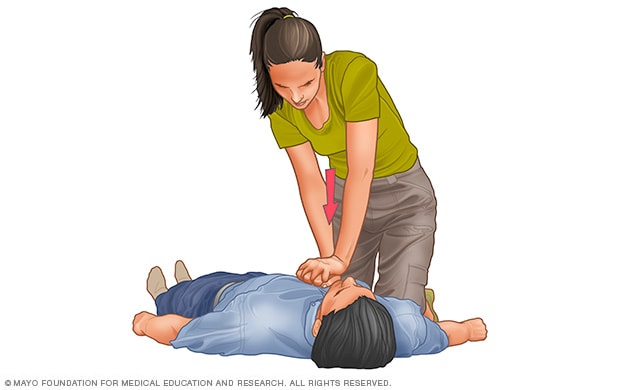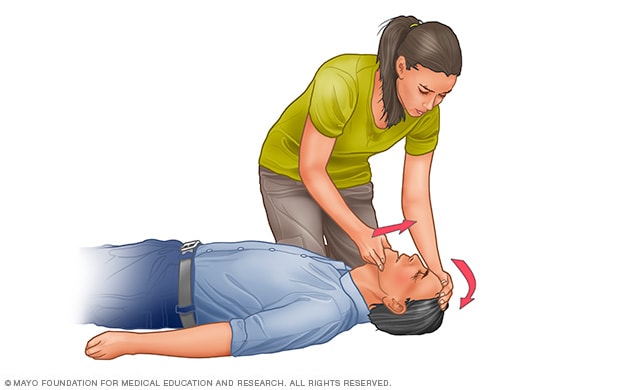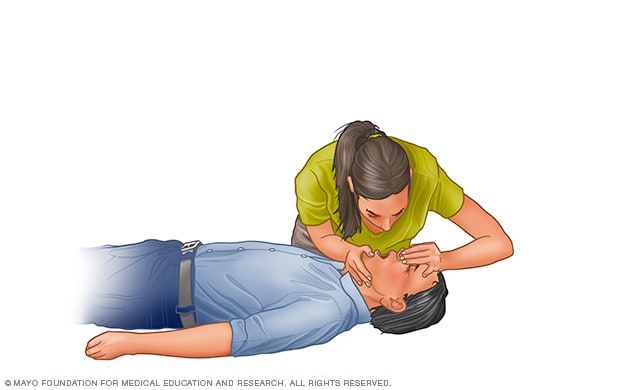Cardiopulmonary resuscitation (CPR): First aid
12 min readCardiopulmonary resuscitation (CPR) is a lifesaving approach that is beneficial in numerous emergencies, these types of as a heart attack or close to drowning, in which someone’s respiration or heartbeat has stopped. The American Coronary heart Affiliation recommends starting CPR with really hard and speedy upper body compressions. This arms-only CPR advice applies to both of those untrained bystanders and initial responders.
If you’re concerned to do CPR or doubtful how to carry out CPR appropriately, know that it can be always improved to try out than to do nothing at all at all. The difference involving doing a little something and doing nothing at all could be someone’s lifetime.
Here’s tips from the American Coronary heart Affiliation:
- Untrained. If you’re not skilled in CPR or anxious about providing rescue breaths, then deliver arms-only CPR. That suggests uninterrupted upper body compressions of a hundred to a hundred and twenty a minute until eventually paramedics get there (described in a lot more detail below). You really don’t need to have to try out rescue respiration.
- Trained and completely ready to go. If you’re well-skilled and assured in your potential, test to see if there is a pulse and respiration. If there is no pulse or respiration in ten seconds, start off upper body compressions. Get started CPR with 30 upper body compressions just before providing two rescue breaths.
- Trained but rusty. If you’ve beforehand obtained CPR teaching but you’re not assured in your talents, then just do upper body compressions at a rate of a hundred to a hundred and twenty a minute (specifics described below).
The previously mentioned tips applies to scenarios in which grown ups, little ones and infants need to have CPR, but not newborns (infants up to four weeks old).
CPR can preserve oxygen-prosperous blood flowing to the mind and other organs until eventually emergency health-related therapy can restore a normal heart rhythm. When the heart stops, your entire body no lengthier receives oxygen-prosperous blood. The absence of oxygen-prosperous blood can cause mind hurt in only a couple minutes.
If you are untrained and have quick access to a cell phone, get in touch with 911 or your area emergency number just before starting CPR. The dispatcher can instruct you in the good strategies until eventually help arrives. To understand CPR effectively, take an accredited initial-aid teaching system, which include CPR and how to use an automated exterior defibrillator (AED).
Just before you start off
Just before starting CPR, test:
- Is the setting harmless for the human being?
- Is the human being acutely aware or unconscious?
- If the human being seems unconscious, tap or shake his or her shoulder and request loudly, “Are you Okay?”
- If the human being would not react and you’re with an additional human being who can help, have 1 human being get in touch with 911 or the area emergency number and get the AED, if 1 is obtainable. Have the other human being start off CPR.
- If you are on your own and have quick access to a telephone, get in touch with 911 or your area emergency number just before starting CPR. Get the AED if 1 is obtainable.
- As before long as an AED is obtainable, deliver 1 shock if instructed by the product, then start off CPR.
Remember to spell C-A-B
Chest compressions
Chest compressions

Chest compressions
To carry out upper body compressions, kneel subsequent to the person’s neck and shoulders. Position the heel of 1 hand more than the center of the person’s upper body and your other hand on best of the initial hand. Hold your elbows straight and posture your shoulders specifically previously mentioned your arms. Utilizing your higher entire body weight, press straight down on the upper body about two inches (5 centimeters), but not a lot more than two.four inches (six centimeters). Drive really hard at a rate of a hundred to a hundred and twenty compressions a minute. If you have not been skilled in CPR, go on upper body compressions until eventually there are indicators of motion or until eventually emergency health-related staff take more than. If you have been skilled in CPR, go on to opening the airway and rescue respiration.
Open up the airway
Open up the airway

Open up the airway
If you’re skilled in CPR and you’ve carried out 30 upper body compressions, open the person’s airway utilizing the head-tilt, chin-raise maneuver. Put your palm on the person’s forehead and gently tilt the head back. Then with the other hand, gently raise the chin forward to open the airway.
Rescue respiration
Rescue respiration

Rescue respiration
Open up the airway utilizing the head-tilt, chin-raise maneuver. Pinch the nostrils shut for mouth-to-mouth respiration and deal with the person’s mouth with yours, producing a seal. Give the initial rescue breath, long lasting 1 second, and view to see if the upper body rises. If it rises, give the second breath. If the upper body would not increase, repeat the head-tilt, chin-raise maneuver initial and then give the second breath. Be very careful not to deliver as well numerous breaths or to breathe with as well a great deal drive. Right after two breaths, instantly restart upper body compressions to restore blood circulation.
The American Coronary heart Affiliation makes use of the letters C-A-B to help individuals keep in mind the buy to carry out the ways of CPR.
- C: compressions
- A: airway
- B: respiration
Compressions: Restore blood circulation
Compressions suggests you are going to use your arms to press down really hard and speedy in a distinct way on the person’s upper body. Compressions are the most significant action in CPR. Comply with these ways for undertaking CPR compressions:
- Put the human being on his or her back on a organization area.
- Kneel subsequent to the person’s neck and shoulders.
- Position the lower palm (heel) of your hand more than the center of the person’s upper body, involving the nipples.
- Position your other hand on best of the initial hand. Hold your elbows straight and posture your shoulders specifically previously mentioned your arms.
- Drive straight down on (compress) the upper body at minimum two inches (5 centimeters) but no a lot more than two.four inches (six centimeters). Use your full entire body weight (not just your arms) when doing compressions.
- Drive really hard at a rate of a hundred to a hundred and twenty compressions a minute. The American Coronary heart Affiliation implies undertaking compressions to the defeat of the music “Stayin’ Alive.” Enable the upper body to spring back (recoil) after each press.
- If you have not been skilled in CPR, go on upper body compressions until eventually there are indicators of motion or until eventually emergency health-related staff take more than. If you have been skilled in CPR, go on to opening the airway and rescue respiration.
Airway: Open up the airway
If you’re skilled in CPR and you’ve carried out 30 upper body compressions, open the person’s airway utilizing the head-tilt, chin-raise maneuver. Put your palm on the person’s forehead and gently tilt the head back. Then with the other hand, gently raise the chin forward to open the airway.
Respiratory: Breathe for the human being
Rescue respiration can be mouth-to-mouth respiration or mouth-to-nose respiration if the mouth is very seriously hurt or can not be opened. Recent tips recommend undertaking rescue respiration utilizing a bag-mask product with a high-efficiency particulate air (HEPA) filter.
- Right after opening the airway (utilizing the head-tilt, chin-raise maneuver), pinch the nostrils shut for mouth-to-mouth respiration and deal with the person’s mouth with yours, producing a seal.
- Prepare to give two rescue breaths. Give the initial rescue breath — long lasting 1 second — and view to see if the upper body rises.
- If the upper body rises, give a second breath.
- If the upper body would not increase, repeat the head-tilt, chin-raise maneuver and then give a second breath. 30 upper body compressions adopted by two rescue breaths is considered 1 cycle. Be very careful not to deliver as well numerous breaths or to breathe with as well a great deal drive.
- Resume upper body compressions to restore blood circulation.
- As before long as an automated exterior defibrillator (AED) is obtainable, utilize it and adhere to the prompts. Give 1 shock, then resume upper body compressions for two a lot more minutes just before providing a second shock. If you’re not skilled to use an AED, a 911 operator or an additional emergency health-related operator may well be capable to give you recommendations. If an AED isn’t obtainable, go to action 5 below.
- Continue CPR until eventually there are indicators of motion or emergency health-related staff take more than.
To carry out CPR on a baby
The method for providing CPR to a baby age one by way of puberty is basically the similar as that for an adult — adhere to the C-A-B ways. The American Coronary heart Affiliation claims you must not delay CPR and provides this tips on how to carry out CPR on a baby:
Compressions: Restore blood circulation
If you are on your own and didn’t see the baby collapse, start out upper body compressions for about two minutes. Then quickly get in touch with 911 or your area emergency number and get the AED if 1 is obtainable.
If you’re on your own and you did see the baby collapse, get in touch with 911 or your area emergency number initial. Then get the AED, if obtainable, and start out CPR. If an additional human being is with you, have that human being get in touch with for help and get the AED though you start out CPR.
- Position the baby on his or her back on a organization area.
- Kneel subsequent to the kid’s neck and shoulders.
- Position two arms (or only 1 hand if the baby is very smaller) on the lower fifty percent of the kid’s breastbone (sternum).
- Utilizing the heel of 1 or both of those arms, push straight down on (compress) the upper body about two inches (approximately 5 centimeters) but not greater than two.four inches (approximately six centimeters). Drive really hard and speedy — a hundred to a hundred and twenty compressions a minute.
- If you have not been skilled in CPR, go on upper body compressions until eventually the baby moves or until eventually emergency health-related staff take more than. If you have been skilled in CPR, open the airway and start out rescue respiration.
Airway: Open up the airway
If you’re skilled in CPR and you’ve carried out 30 upper body compressions, open the kid’s airway utilizing the head-tilt, chin-raise maneuver.
- Position your palm on the kid’s forehead and gently tilt his or her head back.
- With the other hand, gently raise the chin forward to open the airway.
Respiratory: Breathe for the baby
Comply with these ways for mouth-to-mouth respiration for a baby.
- Right after utilizing the head-tilt, chin-raise maneuver to open the airway, pinch the kid’s nostrils shut. Go over the kid’s mouth with yours, producing a seal.
- Breathe into the kid’s mouth for 1 second and view to see if the upper body rises. If it rises, give a second breath. If the upper body would not increase, repeat the head-tilt, chin-raise maneuver initial, and then give the second breath. Be very careful not to deliver as well numerous breaths or to breathe with as well a great deal drive.
- Right after the two breaths, instantly start off the subsequent cycle of compressions and breaths. Observe: If there are two individuals obtainable to do CPR on the baby, adjust rescuers each individual two minutes — or quicker if the rescuer is fatigued — and give 1 to two breaths each individual fifteen compressions.
- As before long as an AED is obtainable, utilize it and adhere to the prompts. As before long as an AED is obtainable, utilize it and adhere to the prompts. Use pediatric pads for little ones older than four weeks old and up to age 8. If pediatric pads aren’t obtainable, use adult pads. Give 1 shock, then restart CPR — starting with upper body compressions — for two a lot more minutes just before providing a second shock. If you’re not skilled to use an AED, a 911 operator or an additional emergency health-related operator may well be capable to give you instructions.
Continue until eventually the baby moves or help arrives.
To carry out CPR on a baby four weeks old or older
Cardiac arrest in babies is typically owing to a absence of oxygen, these types of as from choking. If you know that the baby has an airway blockage, carry out initial aid for choking. If you really don’t know why the baby isn’t respiration, carry out CPR.
Initially, assess the condition. Contact the baby and view for a response, these types of as motion. Don’t shake the baby.
If you can find no response, get in touch with 911 or your area emergency number, then instantly start out CPR.
Comply with the compressions, airway and respiration (C-A-B) method (below) for a baby under age one (besides newborns, which contain babies up to four weeks old):
If you observed the baby collapse, get the AED, if 1 is obtainable, just before starting CPR. If an additional human being is obtainable, have that human being get in touch with for help instantly and get the AED though you stay with the baby and carry out CPR.
Compressions: Restore blood circulation
- Position the baby on his or her back on a organization, flat area, these types of as a table or floor.
- Imagine a horizontal line drawn involving the baby’s nipples. Position two fingers of 1 hand just below this line, in the center of the upper body.
- Gently compress the upper body about one.5 inches (about four centimeters).
- Count aloud as you press in a quite immediate rhythm. You must press at a rate of a hundred to a hundred and twenty compressions a minute, just as you would when providing an adult CPR.
Airway: Open up the airway
Right after 30 compressions, gently tip the head back by lifting the chin with 1 hand and pushing down on the forehead with the other hand.
Respiratory: Breathe for the baby
- Go over the baby’s mouth and nose with your mouth.
- Prepare to give two rescue breaths. Use the toughness of your cheeks to deliver gentle puffs of air (rather of deep breaths from your lungs) to bit by bit breathe into the baby’s mouth 1 time, getting 1 second for the breath. Enjoy to see if the baby’s upper body rises. If it does, give a second rescue breath. If the upper body does not increase, repeat the head-tilt, chin-raise maneuver and then give the second breath.
- If the baby’s upper body still would not increase, go on upper body compressions.
- Give two breaths after each individual 30 upper body compressions. If two individuals are undertaking CPR, give 1 to two breaths after each individual fifteen upper body compressions.
- Continue CPR until eventually you see indicators of lifetime or until eventually health-related staff get there.
May well 01, 2021
.







